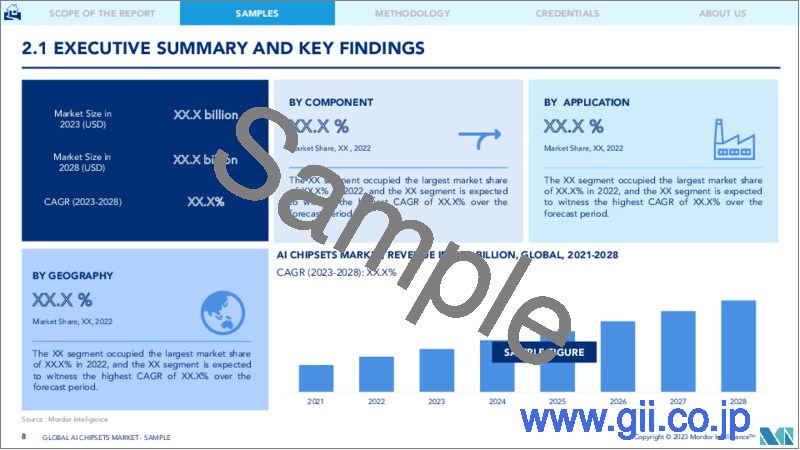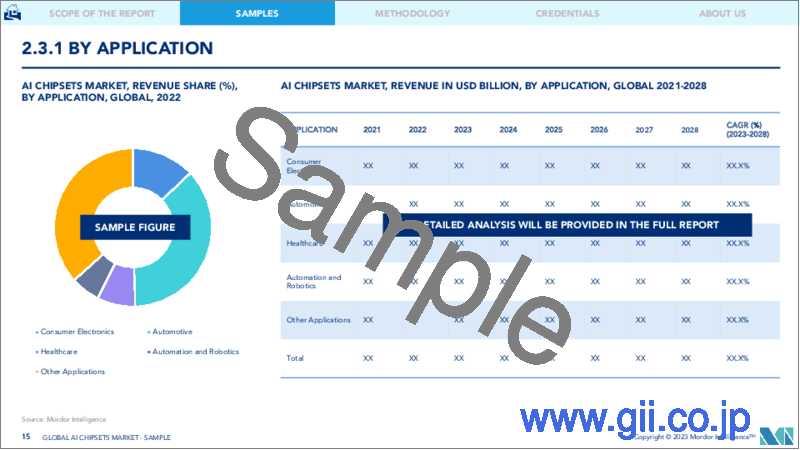|
|
市場調査レポート
商品コード
1195620
AIチップセット市場- 成長、動向、予測(2023年~2028年)Ai Chipsets Market - Growth, Trends, and Forecasts (2023 - 2028) |
||||||
|
● お客様のご希望に応じて、既存データの加工や未掲載情報(例:国別セグメント)の追加などの対応が可能です。 詳細はお問い合わせください。 |
|||||||
価格
| AIチップセット市場- 成長、動向、予測(2023年~2028年) |
|
出版日: 2023年01月23日
発行: Mordor Intelligence
ページ情報: 英文 120 Pages
納期: 2~3営業日
|
ご注意事項 :
本レポートは最新情報反映のため適宜更新し、内容構成変更を行う場合があります。ご検討の際はお問い合わせください。
- 全表示
- 概要
- 目次
概要
AIチップセット市場は、予測期間中に39%のCAGRで推移すると予想されています。
家電業界におけるエッジアナリティクス、自律走行、スマート家電の需要増など、さまざまな要因が市場成長を支えるものと予想されます。
主なハイライト
- 自動車、金融、小売など複数の分野で機械学習の需要が急速に高まっていることが、AI技術の採用を後押ししています。自動車業界におけるAIチップセットの最も有名なアプリケーションには、自律走行技術のL5レベルを達成するための促進要因レスカーの製造が含まれます。
- 人工知能(AI)は、家電製品のほぼすべての側面に入り込んでいます。その用途は携帯電話だけでなく、自動車産業にも広がっています。この成長は、半導体業界に新たな展望を次々ともたらしています。常に増加するデータ量を処理する要件は、AIチップセット市場の成長に影響を与える主要な要素です。
- さらに、AIによって人間が操作するような様々な活動を機械が行えるようになるため、将来的に数多くの機会が開かれると予想されます。さらに、人間を意識したAIシステムの開発に注目が集まっていることも、市場の成長を後押ししています。しかし、熟練労働者の不足と標準およびプロトコルの不在が、市場の成長を抑制しています。
- 人工知能が世界の技術でより地位を確立するにつれて、大量のASICの必要性が高まると予想されます。アマゾンやグーグルなどの企業は、すでにサーバーシリコンの取り組みを強化しているところです。
- 企業は、人工知能などの新しい技術を利用して、新しいAIチップを設計しています。例えば、2021年6月に雑誌「ネイチャー」に掲載された論文によると、グーグルはAIと機械学習を利用して、次世代AIチップの設計に役立てています。同社によると、人間では数カ月かかる作業を、AIなら6時間以内で完了させることができるという。
- さらに、ニューロモルフィック研究の増加は、AIチップの需要を高めると予想されるAIハードウェアの分野の中で、新たな分野となっています。これは、脳の神経細胞(ニューロン)にヒントを得た技術を開発しようというもので、ニューロモルフィックという名称が使われました。ニューロンの低エネルギーかつ高品質な出力は、研究者を熱狂させ、SNN(Spiking Neural Networks)を開発させました。しかし、このSNNは独自のハードウェアを必要とします。
- COVID-19の発生は、AIチップセット市場のサプライチェーンと生産にマイナスの影響を及ぼしました。半導体メーカーへの影響は深刻だっています。消費者サービスの向上と運用コストの削減を目的としたAIの受け入れ、AIアプリケーションの拡大、処理能力の向上、ディープラーニングとニューラルネットワークの採用拡大が、市場の主要な促進要因となっています。世界の半導体サプライチェーンの多くの企業が、労働力の制約のために操業を制限、あるいは停止し、半導体依存の最終製品企業のボトルネックとなっています。
AIチップセットの市場動向
コンシューマーエレクトロニクスが大幅な成長を遂げると予想される
- 半導体チップ不足により、COVID-19のパンデミックにより、世界的に家電製品の生産が停止しました。しかし、このパンデミックはノートパソコン、デスクトップ、ゲーム機などの家電製品に大きな需要を生み出し、製品会社、メーカー、最終消費者に混乱を招いた。機器メーカーは、不安定なコンシューマー・テクノロジー市場からのこの需要に応えることに注力しました。チップ不足と高需要のシナリオは今後2~3年まで続くと予想され、家電用AIチップの需要を後押しします。
- 市場は、複雑な問題に取り組み、分析的な計算を実行するために量子コンピューティング技術の利用が増加することから恩恵を受けるでしょう。例えば、Google LLCの量子コンピュータSycamoreは、およそ200秒で作業を完了することができる最速のコンピュータです。人工知能、機械学習、コンピュータビジョン、ビッグデータ、AR/VRなどの技術が量子コンピュータを実現します。量子コンピュータへの理解が広がることで、AIチップセットの需要が高まり、業界の成長を後押しします。
- AI技術は、自動車や製造業など様々な業界で展開され、プロセスの合理化が図られています。パンデミック時にメーカーがAIベースのソリューションの強化に注力することで、業界は恩恵を受ける可能性があります。例えば、2020年5月、Nvidia Corporationは、新しいデバイス、すなわちEGX Jetson Xavier NXとEGX A100を発売し、EGX Edge AIプラットフォームを更新しました。
- 予測期間中、AIチップセット市場の中で大きな割合を占めるのは、コンシューマーエレクトロニクスカテゴリーであると思われます。タブレットやスマートフォンなどの各種電子機器は、ハイエンドな仕様で市場での需要が高いです。数多くのメーカーが、需要の高まりに対応するため、斬新なAIチップセットを継続的に投入しています。例えば、2022年5月、台湾のチップメーカーであるMediaTekは、AIoT(artificial intelligence of things)デバイス向けのGenioアーキテクチャと、Genio 1200チップを発表しました。MediaTekによると、Genio 1200チップをベースとしたプレミアムAIoTソリューションは、2022年後半に広く利用できるようになるという。
- AIチップセット市場は、高速コンピュータ・プロセッサのニーズの高まりと、より良い顧客サービスと運用コストの削減に対する要求の高まりによって牽引されています。業界は、経験豊富な労働力の不足と標準およびプロトコルの不足によって抑制されています。
アジア太平洋地域が大幅な成長を遂げると予想される
- アジア太平洋市場は、韓国、インド、中国などの新興国により、大きく成長すると予測されています。AIベースのソリューションの受け入れ拡大が、同地域における市場の健全な拡大を支えるでしょう。スマートフォン、タブレット、ラップトップなどの家電製品におけるAIチップセットの用途の広がりは、特に音声コマンドの統合を伴うため、同地域でのAIチップセットの高い普及率につながっています。
- 日本は、国家的なAI政策を採用した最初の国の1つです。日本のアプローチは、AIを社会と経済の両方に役立てることに主眼を置き、AI研究開発スキルの拡大、産業用途のAIシステムの構築、労働市場の変革に向けた労働者の準備などを意図しています。2019年6月、安倍晋三首相は、2025年までに年間25万人のAIスキルを養成する計画を発表しました。
- 音声コマンドの統合、撮影体験の強化、過去の検索に基づく関連データの収集と分類など、スマートフォン、タブレット、ノートパソコンなどの家電製品にAIチップセットを適用した結果、高い普及率が実現されました。
- この地域には、世界最大のスマートフォン・メーカーと半導体企業が存在します。中国、日本、台湾、韓国は、世界のスマートフォン・メーカーの約80%を占めています。人口が最大であることからスマートフォンの利用が増加し、市場の成長を後押しすると考えられます。
- この地域のいくつかの市場プレーヤーは、AIチップの開発と生産の最前線にいます。例えば、2021年8月、中国のハイテク大手であるバイドゥは、チップ業界の主要企業となるべく、第2世代のKunlun AIチップの量産を開始しました。百度によると、新世代のKunlun AIチップは7nmプロセス技術で生産され、計算能力は前世代より2~3倍優れているという。
AIチップセット市場の競合他社分析
- 一部の大小の世界企業が市場に影響を及ぼしているもの、AIチップセット市場は緩やかな統合が予想されます。市場はまだ発展の初期段階にあります。現在の業界における著名な参加者には、Intel Corporation、Samsung Electronics、NVIDIA Corp.、Xilinx Inc、Micron Technologyが含まれます。AIチップセット市場における主導的地位を得るために、これらのプレイヤーは、コラボレーション、新製品イノベーション、市場拡大などの競争的な戦略的前進に取り組んでいます。
- 2021年8月-IBMは、新しいチップ「Telum」を発表し、IBMのクライアントが大規模に深層学習推論を活用できるようになると期待されています。このチップは、クライアントがAI専用ワークロードのためにAIプロセッサーの能力をフルに活用できる集中設計を特徴としており、ローン処理、取引の清算と決済、詐欺検出、マネーロンダリング防止、リスク分析などの金融サービスのワークロードに適しています。
その他の特典です。
- エクセル形式の市場予測(ME)シート
- 3ヶ月間のアナリスト・サポート
目次
第1章 イントロダクション
- 調査の前提条件と市場の定義
- 調査対象範囲
第2章 調査手法
第3章 エグゼクティブサマリー
第4章 マーケットインサイト
- 市場概要
- 産業の魅力- ポーターのファイブフォース分析
- 新規参入業者の脅威
- 買い手の交渉力
- 供給企業の交渉力
- 代替品の脅威
- 競争企業間の敵対関係
- 産業バリューチェーン分析
- COVID-19がAIチップセット市場に与える影響評価
第5章 市場力学
- 市場促進要因
- 自律走行技術に対する需要の増加
- IoTアプリケーション向けエッジアナリティクスの成長
- 市場の抑制要因
- 設計とAIインターフェースの複雑さ
第6章 市場セグメンテーション
- コンポーネント別
- セントラルプロセッシングユニット(CPU)
- グラフィック・プロセッシング・ユニット(GPU)
- ニューラル・ネットワーク・プロセッサ(NNP)
- その他コンポーネント
- アプリケーション別
- コンシューマーエレクトロニクス
- 車載
- ヘルスケア
- 自動化・ロボット
- その他のアプリケーション
- 地域別情報
- 北米
- 欧州
- アジア太平洋地域
- ラテンアメリカ
- 中東地域
第7章 競合情勢
- 企業プロファイル
- Advanced Micro Devices Inc.(AMD)
- Xilinx Inc.
- Graphcore Ltd
- Huawei Technologies Co. Ltd
- IBM Corporation
- Intel Corporation
- NVIDIA Corporation
- Micron Technology Inc.
- Samsung Semiconductor(Samsung Electronics Co. Ltd)
第8章 投資分析
第9章 市場の将来性
目次
Product Code: 64258
The AI chipsets market is anticipated to register a CAGR of 39% during the forecast period. Various factors, such as a rise in demand for edge analytics, autonomous driving, and smart appliances in the consumer electronics industry, are anticipated to support the market growth.
Key Highlights
- The rapidly growing demand for machine learning in multiple sectors, such as automotive, finance, and retail, boosts the adoption of AI technology. The most famous application of AI chipsets in the automotive industry includes manufacturing a driverless car to achieve the L5 level of autonomous technology.
- Artificial intelligence (AI) is entering nearly every aspect of consumer electronics. Its uses are growing beyond cell phones to include the automotive industry. This growth is bringing a slew of new prospects to the semiconductor industry. The requirement to process a constantly rising volume of data is a major element influencing the AI chipset market's growth.
- Moreover, as AI enables machines to perform various activities like those operated by human beings, numerous opportunities are expected to open in the future. Additionally, the growing focus on developing human-aware AI systems is boosting the growth of the market. However, the lack of a skilled workforce and the absence of standards and protocols are restraining the market growth.
- The need for a large number of ASICs is anticipated to rise as artificial intelligence gains more ground in global technology. Companies, such as Amazon and Google, are already in the process of fortifying their server silicon endeavors.
- Companies are using new technologies, such as artificial intelligence, to design new AI chips. For instance, as per a paper published in the journal Nature in June 2021, Google is using AI and machine learning to help design its next generation of AI chips. According to the company, work that takes months for humans can be completed by AI in under six hours.
- Furthermore, the increasing neuromorphic research is an emerging field within the areas of AI hardware anticipated to boost the demand for AI chips. The intuition here is to develop techniques inspired by the real neurons in the brain function; hence, the name neuromorphic was used. The low energy and high-quality output of neurons have enthused researchers to develop Spiking Neural Networks (SNNs). However, these SNNs require hardware of their own.
- The outbreak of COVID-19 has negatively impacted the AI chipsets market's supply chain and production. The impact on semiconductor producers was severe. The acceptance of AI for improving consumer services and reducing operational costs, the expanding number of AI applications, improving processing power, and the growing adoption of deep learning and neural networks are major market drivers. Many companies in the semiconductor supply chain worldwide restricted or even stopped operations due to workforce constraints, causing a bottleneck for semiconductor-dependent end-product companies.
AI Chipsets Market Trends
Consumer Electronics Is Expected to Witness Significant Growth
- Semiconductor chip shortage halted the production of consumer electronics worldwide due to the COVID-19 pandemic. However, the pandemic created a huge demand for consumer electronics, such as laptops, desktops, and gaming consoles, causing chaos for product companies, manufacturers, and end consumers. Equipment manufacturers focused on meeting this demand from the volatile consumer technology market. The chip shortage and high demand scenario are expected to continue until the next 2 to 3 years, driving the demand for AI chips for consumer electronics.
- The market will benefit from the increased use of quantum computing technologies to tackle complicated issues and perform analytical computations. For example, Google LLC's Sycamore quantum computer is the fastest computer, capable of completing work in roughly 200 seconds. Artificial intelligence, machine learning, computer vision, Big Data, AR/VR, and other technologies enable quantum computers. The expanding understanding of quantum computing will boost the demand for AI chipsets, thus boosting the industry's growth.
- AI technologies have been deployed in various industries, including automotive and manufacturing, to streamline processes. The industry may benefit from manufacturers' focus on enhanced AI-based solutions during the pandemic. For example, in May 2020, Nvidia Corporation updated its EGX Edge AI platform by launching new devices, namely, the EGX Jetson Xavier NX and EGX A100.
- The consumer electronics category is likely to occupy a major proportion of the AI chipset market during the forecast period. Various electronic devices, such as tablets and smartphones, are in high demand in the market with high-end specifications. Numerous manufacturers are continuously introducing novel AI chipsets to cater to the rising demand. For instance, in May 2022, MediaTek, a Taiwanese chipmaker, announced the Genio architecture for artificial intelligence of things (AIoT) devices, as well as the Genio 1200 chip. Premium AIoT solutions based on the Genio 1200 chip will be widely accessible in the latter half of 2022, according to MediaTek.
- The AI chipsets market is being driven by the increasing need for high-speed computer processors and increasing demand for better customer services and lower operating costs. The industry is being restrained by a shortage of experienced labor and a lack of standards and protocols.
Asia-Pacific Is Anticipated to Witness Significant Growth
- The Asia-Pacific market is projected to grow significantly due to emerging economies like South Korea, India, and China. The increased acceptance of AI-based solutions will support the market's healthy expansion in the region. The growing application of AI chipsets in consumer electronics, such as smartphones, tablets, and laptops, involves integrating voice commands, among others, which has resulted in the high adoption of AI chipsets in the region.
- Japan was one of the first nations to adopt a national AI policy. Japan's approach, primarily focused on making AI helpful to both society and the economy, intends to expand AI R&D skills, build AI systems with industrial applications, and prepare workers for labor market transformations. In June 2019, Prime Minister Shinzo Abe unveiled a plan to train 250,000 people in AI skills annually by 2025.
- The integration of voice commands, enhancement of photography experience, gathering and sorting relevant data based on previous searches, and other applications of AI chipsets in consumer electronics, such as smartphones, tablets, and laptops, resulted in the high adoption of AI chipsets.
- The region is home to the world's largest smartphone manufacturers and semiconductor companies. China, Japan, Taiwan, and South Korea account for roughly 80% of smartphone manufacturers worldwide. The greatest population has led to increased smartphone usage, which is likely to drive market growth.
- Several market players in the region are at the forefront of developing and producing AI chips. For instance, in August 2021, Baidu, a Chinese tech giant, started mass-producing second-generation Kunlun AI chips to become a major player in the chip industry. According to Baidu, the new generation of Kunlun AI chips is produced using 7 nm process technology, with computational capability 2-3 times better than the previous generation.
AI Chipsets Market Competitor Analysis
- Though some small and large global companies have influenced the market, the AI chipsets market is expected to be moderately consolidated. The market is still in its early stages of development. Some of the prominent participants in the current industry include Intel Corporation, Samsung Electronics, NVIDIA Corp., Xilinx Inc., and Micron Technology. To obtain leading positions in the AI chipsets market, these players are engaged in competitive strategic advancements, such as collaborations, new product innovations, and market expansions.
- August 2021 - IBM announced a new chip, Telum, which is expected to allow IBM clients to leverage deep learning inference at scale. This chip features a centralized design enabling clients to leverage the full power of the AI processor for AI-specific workloads, making it suitable for financial services workloads, such as loan processing, clearing and settlement of trades, fraud detection, anti-money laundering, and risk analysis.
Additional Benefits:
- The market estimate (ME) sheet in Excel format
- 3 months of analyst support
TABLE OF CONTENTS
1 INTRODUCTION
- 1.1 Study Assumptions and Market Definition
- 1.2 Scope of the Study
2 RESEARCH METHODOLOGY
3 EXECUTIVE SUMMARY
4 MARKET INSIGHTS
- 4.1 Market Overview
- 4.2 Industry Attractiveness - Porter's Five Forces Analysis
- 4.2.1 Threat of New Entrants
- 4.2.2 Bargaining Power of Buyers
- 4.2.3 Bargaining Power of Suppliers
- 4.2.4 Threat of Substitute Products
- 4.2.5 Intensity of Competitive Rivalry
- 4.3 Industry Value Chain Analysis
- 4.4 Assessment of the Impact of COVID-19 on the AI Chipsets Market
5 MARKET DYNAMICS
- 5.1 Market Drivers
- 5.1.1 Increase in Demand for Autonomous Driving Technology
- 5.1.2 Growth in Edge Analytics for IoT Application
- 5.2 Market Restraints
- 5.2.1 Complexity in Design and AI Interface
6 MARKET SEGMENTATION
- 6.1 By Component
- 6.1.1 Central Processing Unit (CPU)
- 6.1.2 Graphics Processing Unit (GPU)
- 6.1.3 Neural Network Processor (NNP)
- 6.1.4 Other Components
- 6.2 By Application
- 6.2.1 Consumer Electronics
- 6.2.2 Automotive
- 6.2.3 Healthcare
- 6.2.4 Automation and Robotics
- 6.2.5 Other Applications
- 6.3 By Geography
- 6.3.1 North America
- 6.3.2 Europe
- 6.3.3 Asia-Pacific
- 6.3.4 Latin America
- 6.3.5 Middle-East
7 COMPETITIVE LANDSCAPE
- 7.1 Company Profiles
- 7.1.1 Advanced Micro Devices Inc. (AMD)
- 7.1.2 Xilinx Inc.
- 7.1.3 Graphcore Ltd
- 7.1.4 Huawei Technologies Co. Ltd
- 7.1.5 IBM Corporation
- 7.1.6 Intel Corporation
- 7.1.7 NVIDIA Corporation
- 7.1.8 Micron Technology Inc.
- 7.1.9 Samsung Semiconductor (Samsung Electronics Co. Ltd)
8 INVESTMENT ANALYSIS
9 FUTURE OF THE MARKET
お電話でのお問い合わせ
044-952-0102
( 土日・祝日を除く )




